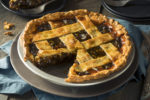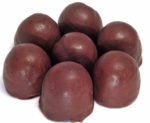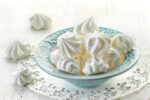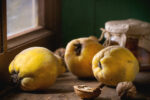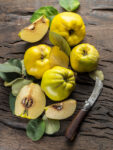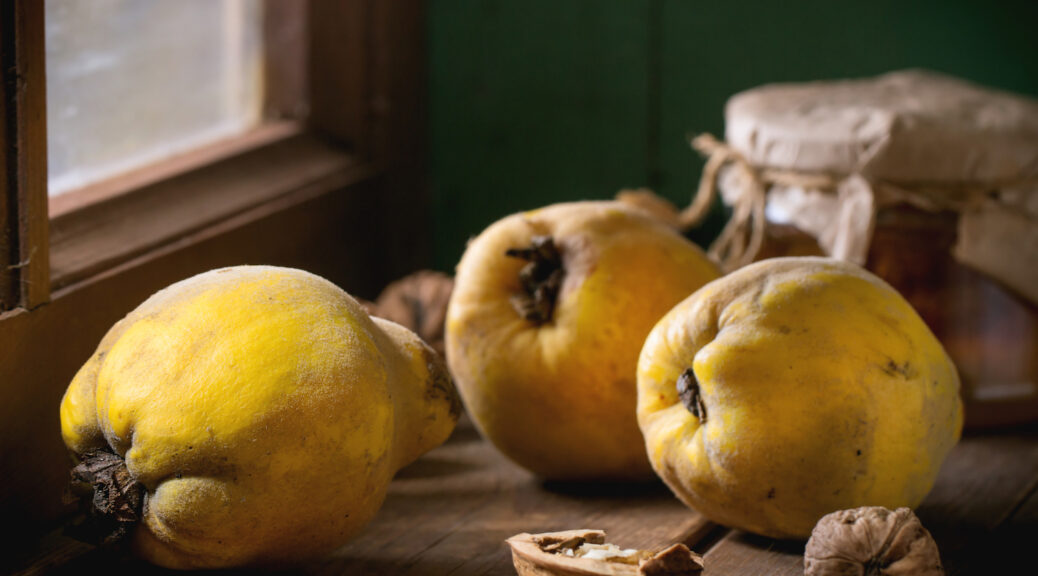
How to Use Quinces, an Old-Fashioned Fruit
Quinces resemble a pear, and are yellow when ripe, but the exterior is bumpy. They have a sour, astringent taste unless completely ripened, so they’re usually cooked. This fruit bruises quickly and very rapidly turns to a dark brown.
The quince tree was brought to the American colonies by English settlers. During the 18th century, there was usually a quince at the lower corner of the vegetable garden [reference].
Today, there aren’t many commercial quince tree orchards in the U.S. They’re considered a specialty fruit and aren’t easy to find in grocery stores. I’ve never eaten a quince, but maybe someday I’ll get the chance.
INFORMATION BELOW FROM 1800s COOKBOOKS:
QUINCES
To keep quinces any length of time, wipe them frequently with a dry cloth and set on a wire tray so that there may be a free circulation of air. Place them in a cool, dry and well-ventilated room. The seeds of the quince are rich in a mucilage-like matter, and they form a jelly-like paste when soaked in water.
BAKED QUINCES
Wash and pare your fruit, cut in half and core (save the skins and cores for jelly). Cover with a large quantity of a thin sugar and water syrup. Bake covered, basting often and turning occasionally until tender and the syrup is rich. Uncover at the last for a short time. Quinces are much improved by combining with sweet apples. When the apples are cooked with them, the quinces become more tender. Quinces and citron and quinces and pears may also be combined. Serve with hard or creamy sauce or with nut cream and sugar.
QUINCE PUDDING
Scald six large quinces very tender, pare off the thin rind, and scrape them to a pulp. Add powdered sugar enough to make them very sweet, and a little pounded ginger and cinnamon. Beat up the yolks of four eggs with some salt and stir in a pint of cream. If you cannot obtain cream, you may substitute one-fourth pound of fresh butter. Mix this with the quince, and bake it in a dish. In a moderate oven,* three-quarters of an hour will be sufficient. Sift powdered sugar over the pudding before it is sent to table. A baked apple pudding may be made in the same manner.
* a moderate oven was about 350 degrees Fahrenheit
QUINCE CHEESE
Have some fine, ripe quinces and pare and core them. Cut them into pieces and weigh them. To each pound of the cut quinces, allow half a pound of the best brown sugar.
Put the cores and parings into a kettle with water enough to cover them, keeping the lid of the kettle closed. When you find that they are all boiled to pieces and quite soft, strain off the water and pour it over the sugar. When it is entirely dissolved, put it over the fire and boil it to a thick syrup, skimming it well.
When no more scum rises, put in the quinces, cover them closely, and boil them all day over a slow fire, stirring them and mashing them down with a spoon till they are a thick smooth paste. Then put it into buttered tin pans or deep dishes and let it set to get cold. It will then turn out so firm that you may cut it into slices like cheese. Keep it in a dry place in broad stone pots. It is intended for the tea-table.
QUINCE JELLY
Take fine ripe yellow quinces, wash them and remove all the blemishes. Cut them in pieces, but do not pare or core them. Put them into a preserving-pan with clear spring water, allowing one pint to twelve large quinces. If you are obliged to use river water, filter it first. Boil them gently till they are all soft and broken. Then put them into a jelly-bag, and do not squeeze it till after the clear liquid has ceased running. Of this you must make the best jelly, allowing to each pint a pound of loaf-sugar.* Having dissolved the sugar in the liquid, boil them together about twenty minutes, or till you have a thick jelly. In the meantime, squeeze out all that is left in the bag. It will not be clear, but you can make of it a very good jelly for common purposes.
* loaf sugar was sold in a hard block, which has to be broken and then pounded into sugar granules.
QUINCE MARMALADE
Quinces make the best marmalade, but crab-apples or any sour apple are also good. Poor quinces, unfit for other use, can be washed and cut in small pieces, coring, but not paring them. Boil slowly two hours, stirring and mashing it fine. Allow three-fourths pound of sugar and a teacup* of water to a pound of fruit. When done, cool, then strain through a colander and put up in glasses or bowls. Peach marmalade is made in the same way.
*teacup – same as a jill or gill; four ounces in the U.S. and five ounces in the U.K.
=================================================
Have You Ever Tried Quinces? Please Leave a Comment Below.
=================================================
